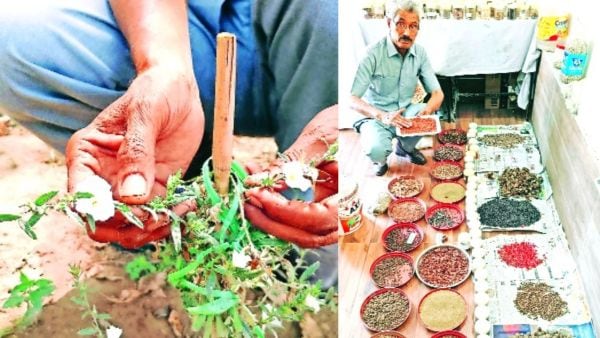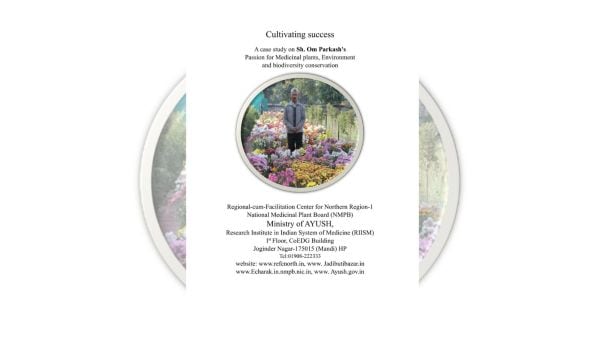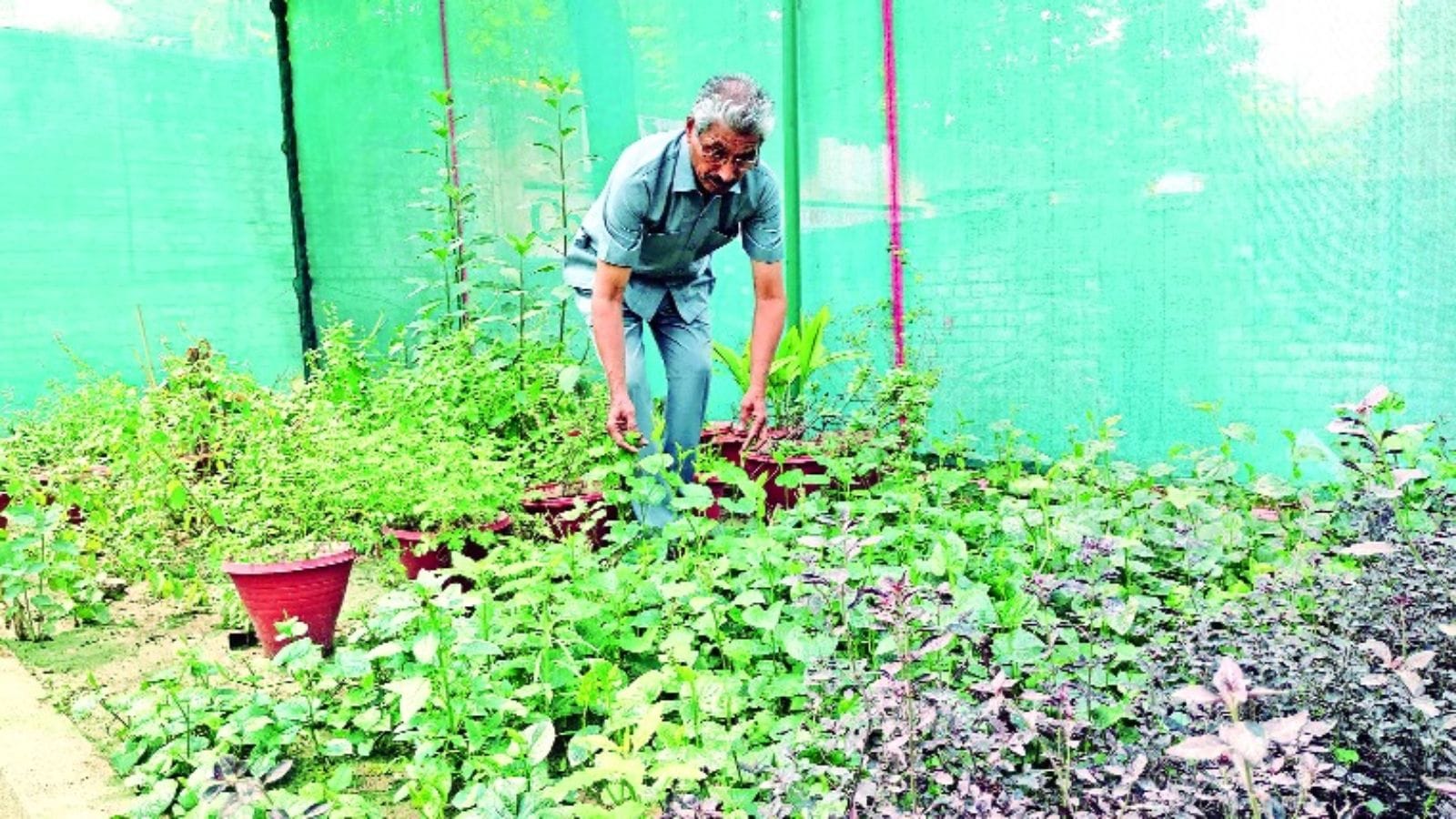Down to earth — that is how people describe Om Parkash, 67.
It is the earth indeed which occupies a prominent and permanent place in the life of this Mohali man — his native place, Manauli village, falls in Sector 83, but he is settled in Sector 71.
When he was in Class 4, a fall from his village jamun tree left him with a slight limp for good.
Story continues below this ad
But he has covered a good distance — on foot, on cycle, on scooter — in search of Punjabi folklore and medicinal plants.
There is a bounce in his step when he goes around showing the herbal garden he has curated at Jitender Veer Sarvitkari Model Senior Secondary School, Sector 71, Mohali.
“Mulethi, touch me not, giloy, shatavari, milk thistle, centred geranium, camphor, sarpgandha, 11 types of pudina, ratti, guggle, kalmegh, pann patta and vasaka,” says the former Punjabi lecturer, reeling out a few names and gesturing towards the ground.
According to him, there are more than 100 species of herbs and shrubs, including medicinal plants, in the herbal garden.
Story continues below this ad
Also, there is a medicinal plant nursery which has 20 types of herbal plants. These plants are supplied to other schools for planting herbal gardens on their campuses.
 There are more than 100 species of herbs and shrubs, including medicinal plants, in the herbal garden. Also, there is a medicinal plant nursery which has 20 types of herbal plants. (Jasbir Malhi)
There are more than 100 species of herbs and shrubs, including medicinal plants, in the herbal garden. Also, there is a medicinal plant nursery which has 20 types of herbal plants. (Jasbir Malhi)
Actually, his love for herbal gardens first bloomed at Government Model Senior Secondary School, Sector 46-D, Chandigarh, in 2002.
He was in charge of the school’s Sohanjana Eco Club which went on to win the Best Eco Club Award by the UT Department of Environment for 2006-07, 2007-08, and 2008-09.
In due course of time, more acknowledgement and appreciation poured in: he was made coordinator of eco clubs of all schools and tasked with establishing herbal gardens, among other things, in all of them.
Story continues below this ad
Interestingly, to help him perform this new role, he was relieved of teaching work on Saturdays.
In 2013, he was promoted as Punjabi lecturer and transferred to GMSSS-16-D, Chandigarh, where he planted a herbal garden and made a herbal plant nursery.
In fact, from 2010 to 2018, he worked for different schools and colleges in the field of medicinal plantation.
And his work impressed one and all. In 2018, the UT Department of Environment asked him to establish a medicinal plant seeds herbarium at Government Smart High School, Sector 49, Chandigarh. “I did that in two months — from August to September,” he says.
Story continues below this ad
The Punjab Department of Forests under the then principal chief conservator of forests (PCCF), Jitendra Sharma, appointed him as consultant for the establishment of herbal gardens in different schools of Punjab from July 2019 to June 2021.
Coordinator of eco clubs of Chandigarh schools from 2010 to 2016, Parkash worked as principal coordinator for all schools and colleges in the city from 2016 to 2022.
Again, from November 2023 to this day, he has been discharging his honorary services as the principal coordinator.
T C Nautiyal, who retired as UT chief conservator of forests (CCF) in February this year, admits “he (Parkash) knows more than us”.
Story continues below this ad
Sharma is impressed with his “selfless passion and domain knowledge”.
“He is a great resource person. We implemented a successful and wonderful project in Punjab with his assistance. The government should identify, encourage and nurture people like him, and map their achievements,” says Sharma, who is also former chief executive officer of the National Medicinal Plants Board.
While Parkash’s research on Punjabi folklore — Puadh De Akhade (Khade) ate jalse — is yet to see the light of day, he himself has become the subject matter of a publication.
Now the regional centre of the National Medicinal Plants Board is bringing out a booklet on him: “Cultivating success: A case study on Sh. Om Parkash’s passion for medicinal plants, environment and biodiversity conservation”.
Story continues below this ad
“This booklet is in recognition of his extraordinary efforts in the field of medicinal plantation. We are bringing out such a publication for the first time. Without any family background in this field, without any training and without any government incentive, he has done a wonderful job. He has been instrumental in creating more than 100 herbal gardens, big and small, in schools and colleges of Chandigarh. His madness is worth emulating,” says Dr Arun Chandan, regional director (north), National Medicinal Plants Board.
 The cover of the booklet brought out by the National Medicinal Plants Board.
The cover of the booklet brought out by the National Medicinal Plants Board.
(Express Photo)
Ranjna Sharma, who wrote this booklet, finds the protagonist “very hardworking, very enthusiastic”.
“He is like a young boy. He is always doing new things for the environment,” says the former Assistant Professor of Environment Education at Post-Graduate Government College for Girls, Sector 42, Chandigarh.
Now she works as a senior scientific officer in the department of environment of Government of NCT of Delhi.
Story continues below this ad
For Prabhjot Sodhi, senior programme director (circular economy), Centre for Environment Education, Parkash is an encyclopaedia.
“He supplied to me at least 15,000 saplings — all free of cost — over a period of five years. Those saplings were meant for a project I was doing for Delhi schools. Once I procured five giloy saplings from him which were planted by the then environment minister Prakash Javadekar.”
How did Parkash acquire such vast knowledge?
“When I was young, I used to visit our neighbourhood hakim (doctor). He would send me to collect jadi-buti (medicinal herbs and plants) from the jungle and would be happy to see what I brought. From one hakim to another, from one pansari (a vendor of drugs, spices and grocery items) to another, from one ayurvedic doctor to another, from one expert to another, from one village elder to another, from one gardener to another, from one forest to another, from one seminar to another, and from one article to another in books and on the internet, I kept on learning about the medicinal herbs and plants,” says the soft-spoken sexagenarian.
Man(ure) of the moment
During Parkash’s stint at the GMSSS-46-D, Chandigarh, herbal plants were distributed to schools and colleges free of cost.
Along with that, organic fertiliser was given too.
Story continues below this ad
He claims his school took the lead in making vermi-compost and manure from leaves in Chandigarh.
Teachers and students from other schools would come to see this work. “In 2009, 84 science teachers from Haryana, who worked as master trainers, had visited our school to see the fertiliser project,” he recalls.
Samwartak Singh, the then UT director of school education, remembers Parkash “doing many innovative things”.
“When it comes to making vermi-compost and manure from leaves, he was among the early risers in the city. He was doing various things to make the earth more beautiful. I encouraged him right from day one,” says Singh, who is now special secretary, Haryana government.
Colourfully, naturally
In 2012, Parkash claims to have made natural Holi colours in Chandigarh for the first time. Again, GMSSS-46-D, Chandigarh, took the lead.
According to Baljinder Kaur, lecturer in Chemistry, GMSSS-46-D, this is how they got different herbal Holi colours:
Pink: Arrowroot + beetroot juice
Yellow: Turmeric juice + arrowroot
Green: Palak juice + dhaniya juice + arrowroot
Orange: Beetroot juice + turmeric juice + arrowroot
Magenta: Beetroot juice + arrowroot. Dry and then again add beetroot juice.
Santosh Kumar, the then CCF from 2010 to 2018, says among the eco clubs of Chandigarh, the Sohanjana Eco Club was the first to make herbal Holi colours.
“Initially, the quantity of colours was limited. When they were encouraged, they produced 50 kg colours. The result was brilliant. Once we put up a stall to sell these colours at the Rose Festival,” says Kumar, who is now chief vigilance officer, National Hydroelectric Power Corporation.
“The club made another brilliant move by withdrawing from the competition after winning the best eco club award many times. It was done just to make sure others got an equal chance to excel.”
Flower power
Parkash is at the forefront of a flower show as well.
He has been spearheading the chrysanthemum show in Mohali.
From 650 guldaudi (chrysanthemum) pots in 2022 to 1,900 guldaudi pots in 2023 to 2,000 guldaudi pots in 2024, he has been going from strength to strength.
His old students have come forward to support the initiative.
“His dedication is exemplary. So, I thought I too should do my bit,” says Bhag Singh Baidwan, from 1985-86 batch and now settled in Canada, who contributes financially to the show.
Prof R K Kohli, Vice-Chancellor of Amity University, Mohali, who inaugurated the last year’s chrysanthemum show, says, “Their effort is commendable, considering their resources and scale are small.”
So, what keeps Parkash going — now in his car?
“I want the earth to be full of fresh air, full of greenery, and its inhabitants full of health. After all, health is wealth. Medicinal plants are great gifts by the earth for mankind to stay healthy. The mother earth is so kind, it takes so much care of us. Our existence is because of the earth. We too should take care of the earth and make it greener and grander. Mera mujh mein kuchh nahin, jo kuchh hai so tera (Nothing is mine within myself. Whatever there is, is yours, O Lord),” says Parkash as he pants for breath, fighting the faint remnants of asthma which afflicted him during his schooldays.


